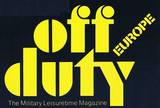"off duty" 1970 - 1997 - eine Freizeit-Zeitung für's US-Militär
Die in diesem amerikanischen (Freizeit-) Shopping-Magazin angepriesenen Hifi- und Video-Produkte waren auschließlich amerikanischen und kanadischen Militärangehörigen zugänglich - also zu kaufen - und vor allem zu ganz ungewöhnlich (verblüffend) niedrigen US $ Military-Preisen. Zu der einführenden "off duty" Seite geht es hier lang. - Um 1970 begann der weltweite Hifi-Boom bis zum 1. Crash 1978 und dann wieder zum 2.Crash um 1990. Über die 20 Jahre nach 2001 lesen Sie mehr in den Kolumnen auf diesen japanischen Seiten.
.
Die ersten Änderungen bei den Produkten sind zu erkennen
Die europäischen Geräte sind bis auf Revox, BRAUN und Tandberg schon "raus". Wenn von einer Type von B&O, Grundig oder Ferrograph in den Clubs nur ein Gerät im ganzen Jahr verkauft wurde, fliegt der Hersteller hochkant raus aus dem Sortiment, wie bei unseren aktuelen Discountern auch.
Dabei darf inzwischen (nach über 40 Jahren) aus der Schule geplaudert werden, daß die europäischen Importeure und Vertriebsfirmen japanischer und amerikanisher Hersteller die Berater (es waren in Wirklichkeit nur ganz normale Verkäufer) in den Audio-Clubs regelrecht geschmiert hatten, ihre Produkte mit Vorrang zu verkaufen. Ein guter pfiffiger "Berater" bekam damals von Pioneer oder JBL unter der Hand 3 oder 5 Dollar pro Gerät und das waren in guten Monaten schnell mal 1.400 Dollar bar auf die Hand. Wie die das mit dem Versteuern (auch in der Schweiz und in Holland) gemacht hatten, war ein Buch mit sieben Siegeln.
.
Just Like the Pros
Open-reel tape recorders give you studio-quality recordings - By THOM PRINGLE - Off Duty I Europe / July 74
.
Recorded on an open-reel tape recorder
WHEN YOU LISTEN to recorded material, chances are that it was, at sometime during its existence, recorded on an open-reel tape recorder. Most likely, it was first recorded on such a recorder when the actual performance took place in the recording studio.
The so-called "master" recordings made of original performances, are recorded on special open-reel machines which use extra wide tape and can record up to 16 separate tracks (in some cases more, with very specialized machines).
Later, during many editing and mixing sessions, the separate tracks on the master tape are equalized and blended together to give the result desired by the producer or director.
To protect the original master from accidental alteration, a production master is then usually produced and used in whatever processes are necessary to mass produce recordings.
Open-reel machines easily met the highest requirements
Some years ago, when tape recording had not achieved the degree of sophistication it has today, several variations of the basic open-reel technique were used in studios to try to overcome the shortcomings of magnetic recording.
Sprocketed film, servo-controlled closed-loop mechanisms and optical recording devices were all used at one time or another.
It wasn't long, though, until improvements in recording equipment and techniques gave professional studios open-reel machines which easily met the highest requirements. Better electronics and head design made increased frequency response possible. The Dolby process dramatically increased dynamic range by reducing the problem of noise to practically a thing of the past.
The improvements in home recorders
The result of the improvements in studio recording techniques was more than just better commercial recordings. The same improvements instituted in studios were incorporated in home recorders to produce machines which far surpassed all audible requirements for high fidelity.
The improvements, however, were not only put into open-reel recorders, but were ideal for improving the performance of cassette units, as well. The latest cassette units (8-track cartridge units, unfortunately, have not been greatly improved) are, indeed, high fidelity and, as far as audible fidelity is concerned, are more than adequate for even the most discerning listener.
Cassette units are serious competition
In today's home audio equipment market, good cassette units are serious competition for open-reel recorders - a fact that is evident in the increasing number of cassette models and the decreasing number of open-reel models.
The question for you, though, is how to decide whether to select a cassette unit or an open-reel unit (or both) for your audio installation.
Do you make first-generation recordings ?
First, and probably most important, is to determine whether you intend to make only first-generation recordings. That is, will you record something from a record or broadcast and be satisfied with simply playing that recording back for listening purposes (first generation) or do you want to re-record that material again to a second or third machine (multiple-generation)?
If you can be satisfied with first-generation work, then cassette tape recordings will be adequate. If you want to play around with your recordings, however, it is recommended that you give serious consideration to open-reel machines.
The recording time / length
Another important factor is the length of the recordings which you want to make. If you like opera, for instance, and want to record unbroken performances without entrusting a valuable recording to the molecule-thin, ultra-long cassette tapes, the only answer for you is open-reel recording.
As an example, you can choose an open-reel machine with a 10 1/2-in. reel capacity and automatic bidirectional playback and have almost six hours (at 3 3/8 ips) of reliable, high-quality reproduction without interruption.
In the case of 4-channel ....
There are some other smaller factors to consider, including editing (which completely rules out cassette units) and 4-channel capability. In the case of 4-channel, you can, of course, matrix 4-channels onto the two channels that cassette units offer, but for discrete 4-channel operation you're almost forced to opt for open-reel, even though some exotic discrete 4-channel cassette units have been announced.
If, by now, you've decided you're still interested in those impressive open-reel units, the kings of tape recording, here are some further factors you'll want to remember when making your final choice.
Special features.
For many audiophiles the special features offered by a model make all the difference in the world between it and other models.
Synchronized record/play.
Here is a feature designed for the person who wants to do some really serious recording. It allows him to switch various tracks of the record head to the play mode thus giving the capability of recording on one track in perfect synchronization with whatever track (or tracks) is being monitored.
It's the exact same technique used by all the leading recording studios to produce low-noise first-generation multi-track recordings. In the consumer market this feature is known by a variety of names such as Simul-Sync, Sel-Synch and Synchro-track, and is available on several of the new machines.
Remember, though, that probably even the most ardent audio buffs will find little use for this complicated feature, so make sure you understand it thoroughly before you decide to invest in it.
Dolby system.
The Dolby noise reduction method now seems to be the generally accepted system by most major manufacturers. But, in spite of the system's popularity, it is still not found as a standard built-in feature of more than a few open-reel decks. Unlike cassette units, open-reel recorders do not suffer from exceptional amounts of noise and, there fore, can perform quite well without dynamic noise limiting.
Nevertheless, the noise they do produce can be dramatically reduced by the addition of Dolby processing. The few machines now available with built-in Dolby circuits boast signal-to-noise ratios in the high 60s and you can except the number of these machines to increase as Dolby IC circuits become more readily available. Of course, there are many add-on Dolby units available, too, so this does not have to be a crucial factor in your buying decision.
.
Transport control.
The trend in the latest top-of-the-line machines is toward completely electrically controlled transport functions. This means that the machines are controlled through a combination of relays and solenoids (relay/solenoid control) and the control buttons on the machine have no mechanical linkages. This allows complete remote control whereas mechanical controls or simple solenoid controlled units may not have this capability.
The latest improvement in transport control is the all-electronic/solenoid system which utilizes IC modules with hundreds of transistors compacted into them to replace the relays normally used in relay/solenoid systems. The ICs also contain logic circuits which prevent improper command sequencing and, thus, do the thinking for you in saving your valuable recordings from being shredded to pieces.
Frequency response.
This is one of the measurable parameters which you should take into consideration when selecting a recorder. Many units today can deliver a record-playback response of 30 to 20,000 (20k) Hertz (Hz) with variance limits of plus or minus three decibels (±3 dB).
Needless to say, this is excellent performance, and if the recorder you're considering has a frequency response close to this, you can be assured that it will deliver high-fidelity sound. The frequency response figures given in our listings are for a tape speed of IV2 inches per second (ips) unless otherwise noted.
.
Signal-to-noise ratio.
Because of the natural character of tape, noise has always been a big problem in tape recording. Compared with a standard signal level, this noise is expressed in a signal-to-noise (S/N) ratio such as 50 dB. S/N ratios have steadily improved (gotten higher) over the past few years - they were commonly in the high 40s but now it's not unusual to find machines with S/N ratios of 60dB even without special noise reduction circuitry. With careful use of a recorder, low noise tape and Dolby noise reduction circuitry, today's audiophile can expect S/N ratios of 65 to 70dB.
The importance of low noise (high S/N ratio) is even greater if you plan to do a lot of dubbing or secondary recording. Every time you rerecord a piece of material you add the noise generated in the recording process to whatever previously existed. Therefore, after several dubs, the noise level may be objectionably high and it's for this reason that major recording studios developed the synchronized playback/record technique.
When selecting a recorder, your lower limit for a S/N ratio should be 50 dB and, of course, as much higher than that as possible. Some of the small portable or inexpensive machines may not be able to meet this limit, but most of the quality stereo units listed will pass the test easily.
.
Flutter and wow.
To measure the stability of movement in a recorder's mechanism, manufacturers measure the amount of average deviation and express it as a percentage called flutter and wow. The idea is to have as little flutter and wow as possible since it has a definite and adverse effect on sound quality.
.



